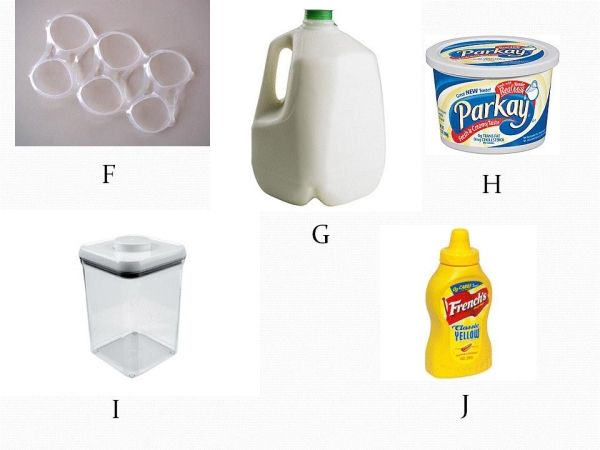It sure does get disgusting to see all the trash lying around
when
you are out finding or hiding a cache. I have noticed that more
and
more of it is plastics. What is particularly disturbing is
that
trash made of plastics can be around for thousands of years
since
they do not easily degrade.
Today I went out to place a cache and picked up ten pieces
of
discarded plastic trash as I went on my journey. First I
headed
north and picked up the five pieces of plastic trash shown
below:

A. This was a piece of plastic wrap which I recognized as low
density polyethylene (LDPE). This plastic is useful because of
its
clarity and ability to stretch. This form of low density
polyethylene has about 4 percent more branching than high
density
polyethylene which causes its strength to be lower.
B. I knew this container could not be polyethylene,
polypropylene
of polystyrene because they would dissolve in the gasoline
additives. A solvent resistant plastic called polyvinyl
chloride (PVC or V) is used for organic solvents. Polyvinyl
chloride is made from
vinyl chloride monomer (VCM). Since VCM is toxic it is reduced to
less
than 2 parts per million in the PVC plastic.
C. The Ziploc bowls were made of polypropylene (PP). This
plastic
is used because it has a higher melting point than LDPE or
HDPE
making it suitable for heating in a microwave. Polypropylene
is
made from polymerization of propylene so it has has 6 hydrogen
atoms in
repeating unit.
D. The water bottle was made from polyethylene terephthalate
(PETE
or PET). Polyethylene terephthalate is popular as a packaging
plastic because it is tough and perfectly clear. Polyethylene
terephthalate is synthesized starting with 2 monomers,
ethylene
glycol and terephthalic acid.
E. The cup is made of polystyrene (PS). Polystyrene can be
formed
into a tough plastic used to make things like plastic utensils.
If
a foaming agent is added Styrofoam is formed. The repeating unit
of
polystyrene has 8 carbon atoms.
I then headed west and encountered five more pieces of
plastic
trash as shown below:

F. I could tell the six pack fastener was another low density
polyethylene (LDPE) by its translucent optical properties and
stretchy character. About twenty-five million tons of LDPE
was
produced worldwide last year. It production volume is growing
at
about 4 percent per year.
G. The milk carton was made of high density polyethylene
(HDPE).
Its higher density structure compared to low density
polyethylene
makes it more suitable where a higher degree of toughness is
required. High density polyethylene is composed of only carbon
and
hydrogen atoms and the ratio of carbon protons to hydrogen
protons
is 3 to one.
H. The butter tub I found was the second encounter with
polypropylene (PP). The polymer backbone consists mainly of
carbon atoms which have an atomic number of 6.
I. This piece of plastic trash I came across was an old
Rubbermaid container. These clear, tough containers are made
of
plastics other than those mentioned above. The 5 most
important
other plastics are polycarbonates, acrylates, methacrylates,
butadienes, and nylon.
J. The last object I picked up was again High Density
Polyethylene
(HDPE). The color was yellow instead of opaque because yellow
dye
#3 had been added during processing.
J. Finally I was at the location where the cache was placed. The
cache
container is located at:
N 29° AB.CDE
W 95° FG.HIJ
You can check your answers for this puzzle on
Geochecker.com.